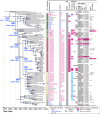Plasmid-mediated acquisition and chromosomal integration of blaCTX-M-14 in a subclade of Escherichia coli ST131- H 30 clade C1
- PMID: 39133024
- PMCID: PMC11373201
- DOI: 10.1128/aac.00817-24
Plasmid-mediated acquisition and chromosomal integration of blaCTX-M-14 in a subclade of Escherichia coli ST131- H 30 clade C1
Abstract
Escherichia coli ST131 is a multidrug-resistant lineage associated with the global spread of extended-spectrum β-lactamase-producing organisms. Particularly, ST131 clade C1 is the most predominant clade in Japan, harboring blaCTX-M-14 at a high frequency. However, the process of resistance gene acquisition and spread remains unclear. Here, we performed whole-genome sequencing of 19 E. coli strains belonging to 12 STs and 12 fimH types collected between 1997 and 2016. Additionally, we analyzed the full-length genome sequences of 96 ST131-H30 clade C0 and C1 strains, including those obtained from this study and those registered in public databases, to understand how ST131 clade C1 acquired and spread blaCTX-M-14. We detected conjugative IncFII plasmids and IncB/O/K/Z plasmids carrying blaCTX-M-14 in diverse genetic lineages of E. coli strains from the 1990s to the 2010s, suggesting that these plasmids played an important role in the spread of blaCTX-M-14. Molecular phylogenetic and molecular clock analyses of the 96 ST131-H30 clade C0 and C1 strains identified 8 subclades. Strains harboring blaCTX-M-14 were clustered in subclades 4 and 5, and it was inferred that clade C1 acquired blaCTX-M-14 around 1993. All 34 strains belonging to subclade 5 possessed blaCTX-M-14 with ISEcp1 upstream at the same chromosomal position, indicating their common ancestor acquired blaCTX-M-14 in a single ISEcp1-mediated transposition event during the early formation of the subclade around 1999. Therefore, both the horizontal transfer of plasmids carrying blaCTX-M-14 to diverse genetic lineages and chromosomal integration in the predominant genetic lineage have contributed to the spread of blaCTX-M-14.
Keywords: Escherichia coli; ST131-H30; blaCTX-M-14; chromosomal integration; extended-spectrum β-lactamase (ESBL).
Conflict of interest statement
The authors declare no conflict of interest.
Figures





Similar articles
-
Occurrence of ESBL-Producing Escherichia coli ST131, Including the H30-Rx and C1-M27 Subclones, Among Urban Seagulls from the United Kingdom.Microb Drug Resist. 2020 Jun;26(6):697-708. doi: 10.1089/mdr.2019.0351. Epub 2019 Dec 12. Microb Drug Resist. 2020. PMID: 32519936
-
Rapid Identification of Different Escherichia coli Sequence Type 131 Clades.Antimicrob Agents Chemother. 2017 Jul 25;61(8):e00179-17. doi: 10.1128/AAC.00179-17. Print 2017 Aug. Antimicrob Agents Chemother. 2017. PMID: 28584160 Free PMC article.
-
Arrangements of Mobile Genetic Elements among Virotype E Subpopulation of Escherichia coli Sequence Type 131 Strains with High Antimicrobial Resistance and Virulence Gene Content.mSphere. 2021 Aug 25;6(4):e0055021. doi: 10.1128/mSphere.00550-21. Epub 2021 Aug 25. mSphere. 2021. PMID: 34431692 Free PMC article.
-
Short- and Long-Read Sequencing Reveals the Presence and Evolution of an IncF Plasmid Harboring blaCTX-M-15 and blaCTX-M-27 Genes in Escherichia coli ST131.Microbiol Spectr. 2023 Aug 17;11(4):e0035623. doi: 10.1128/spectrum.00356-23. Epub 2023 Jul 19. Microbiol Spectr. 2023. PMID: 37466446 Free PMC article.
-
Prevalence of CTX-M-Type Extended-Spectrum β-Lactamase-Producing Escherichia coli B2-O25-ST131 H30R Among Residents in Nonacute Care Facilities in Japan.Microb Drug Resist. 2018 Dec;24(10):1513-1520. doi: 10.1089/mdr.2018.0068. Epub 2018 May 23. Microb Drug Resist. 2018. PMID: 29791251
References
-
- Petty NK, Ben Zakour NL, Stanton-Cook M, Skippington E, Totsika M, Forde BM, Phan M-D, Gomes Moriel D, Peters KM, Davies M, Rogers BA, Dougan G, Rodriguez-Baño J, Pascual A, Pitout JDD, Upton M, Paterson DL, Walsh TR, Schembri MA, Beatson SA. 2014. Global dissemination of a multidrug resistant Escherichia coli clone. Proc Natl Acad Sci U S A 111:5694–5699. doi:10.1073/pnas.1322678111 - DOI - PMC - PubMed
MeSH terms
Substances
Grants and funding
LinkOut - more resources
Full Text Sources
Molecular Biology Databases

